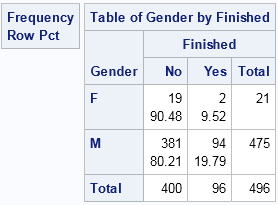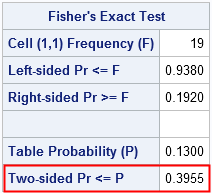I wanna be an airborne ranger,
Live the life of guts and danger.*
If you are an 80's movie buff, you might remember the scene in The Breakfast Club where Bender, the juvenile delinquent played by Judd Nelson, distracts the principal by running through the school singing this song. Recently, the US Army Ranger School has been in the news because, for the first time, two women passed the rigorous training regime.
It is extremely difficult for anyone, regardless of gender, to pass the course. Only 94 out of 381 males passed this year's course, and only two of the original 19 females graduated.
Those numbers imply that that approximately 20% of males graduated, whereas only 10% of females graduated. However, the initial female group was so small that I wondered whether this difference was statistically significant. Do these data indicate that there is a higher probability of passing the ranger course if you are male?
It turns out that the difference is not statistically significant. You can use PROC FREQ in Base SAS to analyze the data, as follows:
data Rangers;
input Gender $ Finished $ Count;
datalines;
M Yes 94
M No 381
F Yes 2
F No 19
;
proc Freq data=Rangers;
weight Count;
tables Gender * Finished / nocol nopercent
chisq
or(cl=score)
riskdiff(cl=score column=2 norisks);
run; |

The first row of the crosstabulation shows the counts and percentages of women who failed or passed the ranger course. The second row presents the counts and percentages for men. The first column shows that about 90% of the women failed the course, as compared with 80% of the men.
The options on the TABLES statement request several statistical tests. The CHISQ option requests a chi-square test for association between gender and finishing the course. Because one cell has fewer than 5 counts, it is best to look at the exact Fisher test.

The p-value is not small, so there is insufficient evidence to reject the hypothesis that finishing the course is independent of gender. The other statistical tests (not shown) show similar results. These data do not suggest that gender significantly affects the odds of failing or the risk of failing. The confidence interval for the odds ratio includes 1; the confidence interval for the risk difference includes 0.
To obtain statistical significance, a larger cadre of women would need to be in the study. With the US Army re-evaluating the role of women in combat positions, maybe that will occur in the near future.
For now, congratulations to Capt. Kristen Griest and 1st Lt. Shaye Haver, the hard-working women who made history by passing the ranger course, and to all the women who attempted. The data indicate that the pass rate between men and women is not statistically significant. I think that is quite an achievement.
* The second line of this cadence has many variations, including some that are not safe for work.

11 Comments
Very interesting.
The course is so difficult that soldiers over the age of 26 aren't allowed to apply. At least that was the case when I was on active duty over 30 years ago.
The only possible exceptions were very senior officers who were just getting their ticket punched. That didn't happen too often.
I heard today that there were some women in the next class who, if they passed the next tests, would graduate in a month and one of those women was over 30 so I think the 26 and under rule isn't in place any longer.
Maybe 30 is the new 26?
I keep telling myself that 60 is the new 40 !!!!
I think about 25% of men graduated , 94/381*100 = 24.67%
otherwise, I think you calculating it from the frequency table instead . 94/475*100
The observed graduation rates are roughly 10% and 20% for women and men, respectively. Certainly you're not suggesting that there was enough power to detect a difference of interest or that decisions should be made by statistical significance alone?
The article does not make either of those statements.
The set of statements "The p-value is not small, so there is insufficient evidence to reject the hypothesis that finishing the course is independent of gender. The other statistical tests (not shown) show similar results. These data do not suggest that gender significantly affects the odds of failing or the risk of failing." and "To obtain statistical significance, a larger cadre of women would need to be in the study." sure makes it look like it's only statistical significance that matters. I know you know that's not the case. I'm only stating that the article gives the impression that only statistical significance matters.
Shouldn't the TOTAL be 19 females and 381 males (making the numbers that did not finish 19-2=17 females and 381-94=257 males)?
Interesting. I just checked the CNN article that I cited and they have revised the originally reported numbers. On the morning of August 21, the numbers the CNN story said that 381 men and 19 females dropped out. Now they say that 19 women and 380 men started the program. I don't know what the true numbers are. However, the chi-square test is still not significant if you use